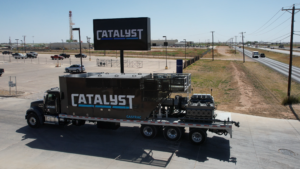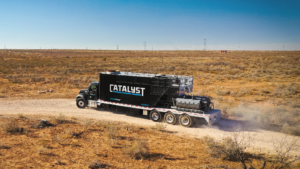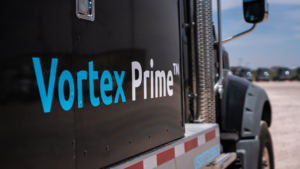by Paul Wiseman
In 1965 Gordon Moore—who accidentally invented Moore’s Law—observed that the number of transistors on a microchip doubled about every two years. That law has sometimes been modified to symbolize the increasingly fast pace of advances in computer speed and capacity in the decades since.
Mr. Moore’s law is certainly at home today in the world of hydraulic fracturing. While frac speed may not be doubling every two years, the information available to fuel innovation seems to double every few days.
Gas-fired Direct Drive Turbine Power
 Midland-based Catalyst Energy Services officially opened its doors in April of 2018. The company’s founders, including President and CEO Bobby Chapman and Executive Vice President and Chief Operating Officer Seth Moore, had a plan. Their idea for a revolutionary frac unit design was the concept behind starting the company.
Midland-based Catalyst Energy Services officially opened its doors in April of 2018. The company’s founders, including President and CEO Bobby Chapman and Executive Vice President and Chief Operating Officer Seth Moore, had a plan. Their idea for a revolutionary frac unit design was the concept behind starting the company.
“We were looking to creating a technology that would have a major impact on the frac formula as we know it,” Moore recalled. Cost was a key factor because frac procedures have been capital intensive operations, especially regarding the number of people and the size and capacity of the equipment involved, along with high fuel consumption.
“We realized that if we could create a high horsepower frac unit, it would take fewer of those units to complete the work,” he said. Fewer units would require less fuel, fewer people, and more competitive capital structure—all of which would cut frac costs significantly. A smaller unit count would also require less space on the pad.
To meet the more intense power requirements they turned to gas turbines and more powerful pumps. He acknowledged that turbines had previously been tried and found wanting—but Catalyst’s engineering team found a system that worked well. “This frac unit consists of a high horsepower gas turbine engine, a high horsepower quintaplex pump, and all the requisite drive train to directly connect them,” Moor explained.
By using turbines instead of the more traditional diesel-powered reciprocating engines, it allows them to use LNG, CNG trucked from nearby, or, ideally, rescued flare gas. “The Holy Grail, I think, is capturing that gas just before it goes to a flare boom, and using it,” he said. “It’s marched up to the gallows to end in a terrible death, and we take that” and use it to power the frac pump.
After a little more than two years of testing and tweaking, they released the Vortex Prime system in February of 2022.
With diesel costs skyrocketing as opposed to field gas that is much less expensive, the fuel savings for the new system look promising. With early field results Moore said that, by comparing diesel prices against the cost of processing CNG, transporting and decompressing the gas for use, they can project fuel savings of $1 million per month per fleet. 
Fuel accounts for a large percentage of total frac costs, so using CNG makes a significant difference in those numbers.
Supply chain issues plagued almost all industries—and consumers—early in the year, but Moore says some of that has eased in the frac space. Last-mile delivery for frac sand is better, and “there is ample horsepower out, if it could be crewed. But from a workforce perspective, it’s been challenging to grow.”
He noted that Catalyst’s three current fleets are booked out into 2023, and that they turn down new orders often. They are looking to add at one more by year’s end, to accommodate more work. Staffing fleets will remain a challenge. Moore feels that Catalyst has done better than most at keeping people they have, but finding new workers is one of their biggest issues.
Tweaks in Frac Spacing Vary by Basin and Formation
Saving money on the frac is indeed important, and the flip side of that is designing the frac job to maximize the well’s production, extending its payout as long as is practical. This is another area being informed by the rising flood of data and processing power, says Steve Hendrickson, president of Ralph E. Davis Associates, an Opportune LLP company. Ralph E. Davis is an international independent petroleum engineering firm.
In November of 2021 Hendrickson discussed research showing issues that occur when child horizontal wells were placed too close to the parent. Among those were chemical interactions and reducing production from the parent well. Since then some lessons have been learned, he said, while noting that no two basins or formations are exactly alike.
“Spacing is basin-specific. We can’t say the right answer is x wells per section or they should be x feet apart. It depends on the formation,” he said.
 Acknowledging a typical producer’s desire to drill as many wells as possible in order to maximize production, he said there can come a point of diminishing returns. The first inkling of overly tight spacing came about in Oklahoma’s Anadarko Basin.
Acknowledging a typical producer’s desire to drill as many wells as possible in order to maximize production, he said there can come a point of diminishing returns. The first inkling of overly tight spacing came about in Oklahoma’s Anadarko Basin.
“I think a lot of the plays have gone through that. There’s been a bit of experimentation, trying to push the limits.” In that experimentation, he’s observed a couple of trends. One is that producers change more than one thing at a time, making it harder to pinpoint which change made whatever difference was observed. When a producer adjusts well spacing, frac count, fluid type, and proppant intensity all at once, “that makes it, on the one hand, hard to understand what’s causing the performance change,” Hendrickson said.
“Another thing is that it takes time to see where these wells are going.” It takes more than a few months of production history to predict how those changes will affect a well’s long-term production. Plus, since different wells have a certain “random variability,” one well’s production could vary from another even if all procedures for both were exactly the same.
Even so, Hendrickson has seen many producers move toward “up-spacing,” resisting the urge to overdrill a field. Producers are seeing that one additional closely spaced well may not actually give them anything that would not have come from existing wells, over a longer term.
Producers are learning, “I drill three wells I get x per well. I drill four wells and I get .75x per well—that’s the same volume, but I drill one more well.” And it’s done at much additional expense. Drilling four wells does, said Hendrickson, “get it out faster,” but “generally speaking, that’s not the optimal development.”
Investor desire for cash flow versus the old model of growth has influenced the change as well. Planning based on the new model of capital discipline reduces the push to drill any more wells than production will pay for.
Over the years Hendrickson has seen fracs change from large mesh sand and high viscosity fluids to less sand, fewer chemicals, and less-treated water and lower horsepower requirements, all aimed at reducing costs while boosting production. The move from vertical to horizontal fracturing was also part of those changes.
“That was the advent of the slickwater fracs,” he said. “You just had enough [treatment] added to that, that they could support up to, say, two pounds of sand per gallon.” Experiments continue with the optimal frac number and amounts of fluid and sand to maximize production, with results varying from basin to basin.
The March to Electric Fracs
Evolution Well Services, now based in Houston after being founded in Canada, began R&D on electric fracturing way back in 2011. Vice President of Digital Strategy & Business Development Nick Ruppelt said the company spent five years in that R&D process before pumping their first electric stage in 2016.
In 2016 electric fracturing was not unheard of but it was rarely done and even more rarely done well. With deep investments in the system before its release, Evolution has seen what Ruppelt called “hyperbolic growth” since pumping that initial stage as they have focused on doing the job well.
“It’s not a simple task to electrify something that consumes upwards of 30mw of power in a bubble setting,” he said. Because of the enormity and complexity involved, Ruppelt said converting should be carefully considered to make sure all aspects of feasibility are considered.
The benefits can be great in both cost savings and environmental improvements. Converting all pumps to electric is one step, but reliably providing the necessary 30mw of power—enough to run a small city—to a remote location is another. Evolution uses natural gas powered turbines to run the necessary generators. The company is proud of the fact that they use 100 percent produced gas to fire the turbines.
That the power demand is so large—and intermittent—makes using the grid to run electric fracs very difficult. Ruppelt noted that some companies do use grid power in a few locations, but that process is generally more complicated and less reliable than using gas from the location to produce electricity on the location.
By using essentially wholesale site gas instead of increasingly expensive diesel, Ruppelt estimates that they save $30 million dollars per year per fleet on fuel costs—at prices in effect at this writing. That switch also reduces CO2 emissions by about 27 percent he said, quoting the Environmental Protection Agency website.
“If you’re not using natural gas to power your operations in the Permian Basin, you need to focus on it because the diesel prices are so incredibly high,” he recommended.
Simulfracs
Simulfracs are another area in which frac technologies and methods are reaching for greater efficiency. When asked about that, Ruppelt responded, “Every single one of our fleets in Texas right now is doing simulfracs.” That amounts to seven total fleets. The company also works in the Marcellus.
By using gas turbines that create 7,000 hp each instead of diesels making just 2,500 hp, their equipment trailers require less space, adding to the benefits of a simulfrac. “Our footprint is about half that of a diesel fleet,” he said. “We can fit about two-and-a-half trailers into the foot print of one” of the diesel variety trailers.
Long-term business model
Evolution’s typical client is a supermajor or a large independent with an innovative outlook, Ruppelt said. With these companies Evolution has signed long term contracts, which has helped them weather downturns in two ways. One is that, even during the depths of the 2020 quarantines, their business stayed strong and, second, that job security was one of the factors that allowed them to hire and keep good staff. In fact, said Ruppelt, the company continued to invest in technology R&D during 2020-2021, hiring more engineers to do that research.
Continual R&D and innovation is helping clean up balance sheets, well sites, and air quality, checking a lot of boxes in the process. In the frac sector as with most areas these days, there is no such thing as standing still. Those who are not going forward are sliding backwards.









